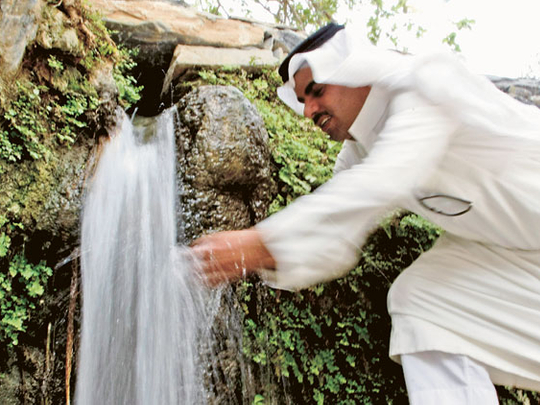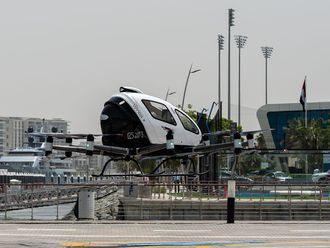
Khobar/London: Long before it understood the value of oil, Saudi Arabia knew the worth of water.
But the leading oil exporter's water challenges are growing as energy-intensive desalination erodes oil revenues while peak water looms more ominously than peak oil — the theory that supplies are at or near their limit, with nowhere to go but down.
Water use in the kingdom is already almost double the per capita global average and increasing at an ever faster rate with the rapid expansion of Saudi Arabia's population and industrial development.
Riyadh in 2008 abandoned what was in retrospect clearly a flawed plan to achieve self-sufficiency in wheat and aims to be 100 per cent reliant on imports by 2016.
"The decision to import is to preserve water," said Saudi Deputy Minister of Agriculture for Research and Development Abdullah Al Obaid. "It's not a matter of cost. The government buys wheat at prices higher than in the local market."
Critics complain the policies are still not joined up, however, and say the risk is that Saudi farmers will turn to even thirstier cash crops.
"Many farmers who used to grow wheat start growing fodder [animal feed] instead that generates quick cash. But unfortunately fodder's use of water is four times more than for wheat," said Abdul Aziz Rabih Al Harbi, professor at the King Saud University and a member of the agriculture committee at the Riyadh Chamber of Commerce and Industry.
"Other farmers grow palm instead of wheat and this also consumes huge amounts of water and may not achieve the desired goal of efficient water consumption."
As one of the kingdom's primary sources of development and employment, agriculture is a sensitive political issue and so scaling back is not an option.
But with such a small amount of the country suitable for cultivation, a comprehensive solution is required, industry officials say.
A water quota for the agriculture sector and a push to reduce wheat consumption, which is rising by 5 per cent a year, are possible solutions, said Hasan Al Shehri, chairman of the Cooperative Association of Wheat in the kingdom and general manager at the Saudi Agricultural Development Co.
"We need coordination between the ministries of agriculture and water," said Al Shehri.
Precious exploration
The lack of water also poses a major challenge to the kingdom's hopes to develop its mining sector to diversify its economy given the water-intensive nature of the industry.
"Gold is there but we don't have water," Mohammad Hani Al Dabbagh, vice-president of precious metals and exploration at state-controlled minerals firm Saudi Arabian Mining Co said. "Water is as precious as gold."
Saudi Minister of Water and Power Abdullah Al Hussain said in May the nation's demand for water is rising by more than 7 per cent each year and that more than 500 billion riyals (Dh488.44 billion) of investment in the water and power sector will be required over the next decade. Consultancy Booz and Company estimates Saudi water use is around 950 cubic metres per capita each year, compared with a world average of 500 cubic metres.
Agriculture is the single biggest user, absorbing 85-90 per cent of the kingdom's supplies, according to the deputy minister of agriculture for research and development. Of that, almost 80-85 per cent came from underground aquifers.
With average annual rainfall around 100mm, the ancient Saudi underground aquifers are its lifeblood. But just as peak oil theorists believe the world's conventional oil supplies are at or near their peak, proponents of the peak water view have said the resource has been irreversibly drained.
Booz and Company has said some of the region's aquifers — also referred to as "fossil water" as they contain rain that fell thousands of years ago — have become too salty to drink.
Injecting water into oilfields has also had an impact, although sea water is now generally used to maintain reservoir pressure.
The alternative to desalination — the energy-intensive process of converting salt water to fresh water — robs Saudi Arabia of its other precious resource, oil, by eating up both fuel and fuel revenues.
Saudi Arabia's Saline Water Conversion Corp (SWCC) produces 3.36 million cubic metres of desalinated water per day, a daily cost of 8.6 million riyals (Dh8.4 billion) based on the SWCC's 2009 figures — the latest available — when the cost of producing one cubic metre of desalinated water was 2.57 riyals. Transporting it added an extra 1.12 riyals per cubic metre.
Analysts and industry leaders say the authorities need to pass on more of the costs to the end-user to curb demand and reduce waste — an argument that holds true for power and fuel but which requires very careful handling in the case of water.
"It is necessary to raise water tariffs," Isao Takekoh, a director at the US-based International Desalination Association, said. "But it should be conducted very carefully and step-by-step because water is, needless to say, indispensable for human life."
By burning up energy, desalination reduces the amount of crude available for export markets. Takekoh estimated energy represented 45 to 55 per cent of unit production costs.












